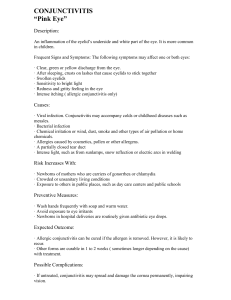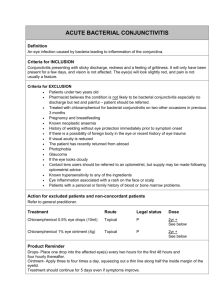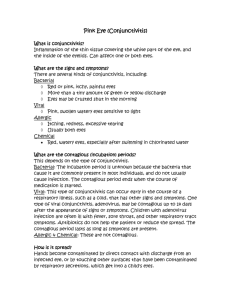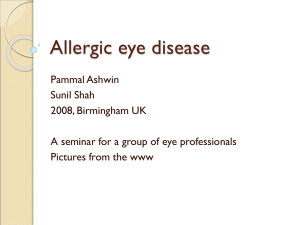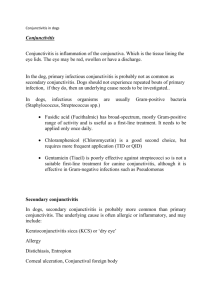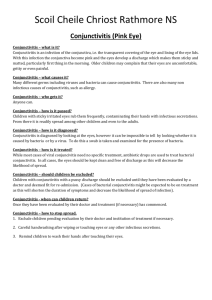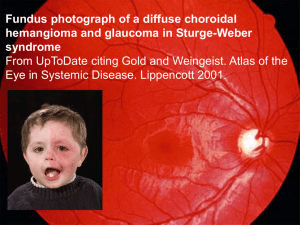Document
advertisement
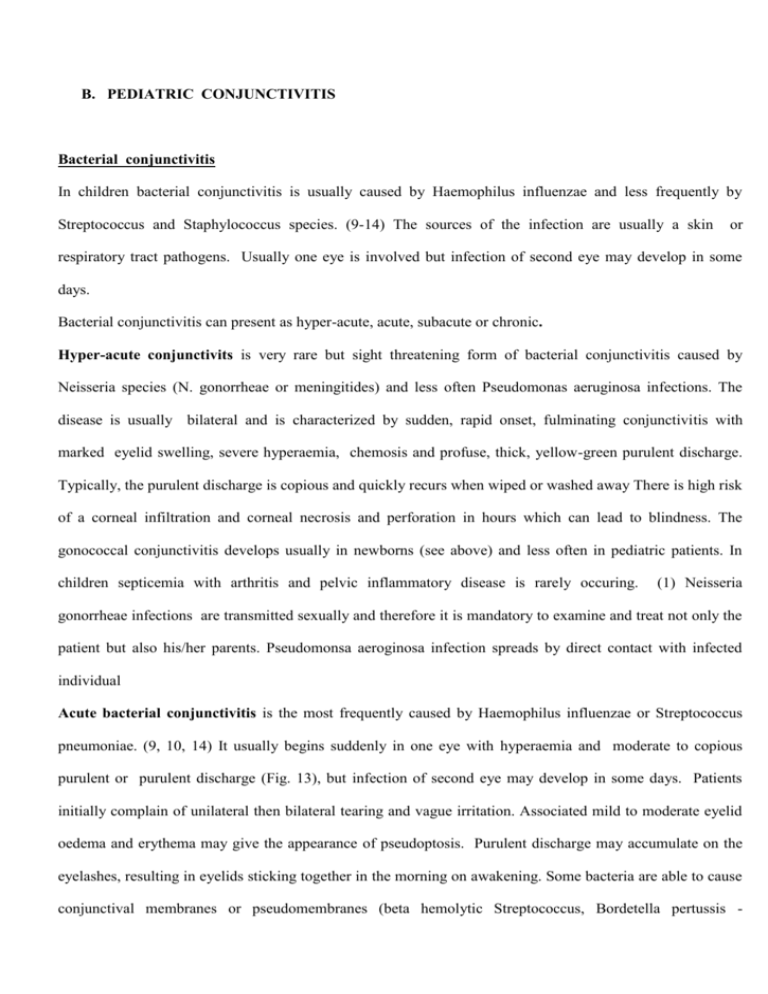
B. PEDIATRIC CONJUNCTIVITIS Bacterial conjunctivitis In children bacterial conjunctivitis is usually caused by Haemophilus influenzae and less frequently by Streptococcus and Staphylococcus species. (9-14) The sources of the infection are usually a skin or respiratory tract pathogens. Usually one eye is involved but infection of second eye may develop in some days. Bacterial conjunctivitis can present as hyper-acute, acute, subacute or chronic. Hyper-acute conjunctivits is very rare but sight threatening form of bacterial conjunctivitis caused by Neisseria species (N. gonorrheae or meningitides) and less often Pseudomonas aeruginosa infections. The disease is usually bilateral and is characterized by sudden, rapid onset, fulminating conjunctivitis with marked eyelid swelling, severe hyperaemia, chemosis and profuse, thick, yellow-green purulent discharge. Typically, the purulent discharge is copious and quickly recurs when wiped or washed away There is high risk of a corneal infiltration and corneal necrosis and perforation in hours which can lead to blindness. The gonococcal conjunctivitis develops usually in newborns (see above) and less often in pediatric patients. In children septicemia with arthritis and pelvic inflammatory disease is rarely occuring. (1) Neisseria gonorrheae infections are transmitted sexually and therefore it is mandatory to examine and treat not only the patient but also his/her parents. Pseudomonsa aeroginosa infection spreads by direct contact with infected individual Acute bacterial conjunctivitis is the most frequently caused by Haemophilus influenzae or Streptococcus pneumoniae. (9, 10, 14) It usually begins suddenly in one eye with hyperaemia and moderate to copious purulent or purulent discharge (Fig. 13), but infection of second eye may develop in some days. Patients initially complain of unilateral then bilateral tearing and vague irritation. Associated mild to moderate eyelid oedema and erythema may give the appearance of pseudoptosis. Purulent discharge may accumulate on the eyelashes, resulting in eyelids sticking together in the morning on awakening. Some bacteria are able to cause conjunctival membranes or pseudomembranes (beta hemolytic Streptococcus, Bordetella pertussis - diphtheria). Very rarely acute conjunctivitis can progress to keratitis and infection of orbital tissue (preseptal cellulites). Rare systemic associated findings are sinusitis, rhinitis and otitis media. (6) Fig. 13 Acute bacterial conjunctivitis with purulent discharge and conjuctival hyperaemia. In subacute or chronic conjunctivitis the most frequent cause are Streptococcus, Staphylococcus and Moraxella species. (10, 13) The duration of infections is on average 5-7 days and is usually mild and selflimiting. The patients present with moderate purulent discharge, mild conjunctival hyperaemia and crustings on the eyelids and/or eyelashes (dried purulent discharge). Sometimes conjuctival papillary reaction may be seen in chronic bacterial conjunctivitis. (Fig 14) Corneal involvement is very rare in subacute and chronic bacterial conjunctivitis in children but marginal conjunctivitis may occur in staphylococcal conjunctivitis as an result of an immune-mediated reaction to staphylococcal toxins. Pre-auricular lymph nods are not enlarged. Fig. 14 Conjunctival papillary reaction in chronic bacterial conjunctivitis In children it may very rarely progress to keratitis and infection of orbital tissue (preseptal cellulites). The most typical sign of bacterial conjunctivitis is purulent discharge and eyelids sealing in the morning upon awakening. In neonate and infants it is necessary to exclude nasolacrimal duct obstruction as a cause of bacterial conjunctivitis. Diagnosis of bacterial conjunctivitis In hyper-acute conjunctivitis it is mandatory to perform promptly slide stains, cultures and antibiotic sensitivity. In acute, subacute or chronic conjunctivitis diagnosis is made on the basis of medical history and eye examination. Usually slide stains, cultures or cytology are not necessary to prove the diagnosis. (6) Diagnostic tests are indicated in difficult clinical cases, recurrent conjunctivitis and in patients not responding to medication. One have to remember that in patients with bacterial conjunctivitis treated previously with antibiotics the results of slide stains and cultures are very often negative. Usually Gram stain is used for direct identification of causative bacteria. The conjunctival smears and scrapings can be cultured on various media, the most popular is blood agar. (see below) In infants it is necessary to exclude nasolacrimal duct obstruction as a cause of bacterial conjunctivitis. Treatment of bacterial conjunctivitis Patient with hyper-acute bacterial conjunctivitis patient should be admitted to the hospital and slide stains, cultures and antibiotic sensitivity are performed. Treatment is started immediately with systemic antibiotics (basic therapy) – in children with weight less than 45 kg - ceftriaxione (125 mg IM) or spectinomycin 40 mg/kg (maximum dose 2 gm) single doses. In older children single doses of 1 gm of ceftriaxione IM, 500 mg orally of ciprofloxacin or spectinomycin 2gm IM have been proved to be effective. (6, 15) Topical last-generation fluoroquinolones every 1 h can also be administered. Afterwards therapy is adjusted according to sensitivity of the cultured organism. Lavage of purulent discharge from the infected eyes should be considered. In acute, subacute and chronic conjunctivitis treatment is started with broad spectrum topical antibiotics. Antibiotic therapy usually speeds the resolution and lessens the severity of the disease. Since ordinary bacterial conjunctivitis very often is self-limited less expensive option like aminoglycosides may be selected but fluoroquinolones are used more and more frequently nowadays. (6, 16) If this therapy is not effective after 7 days switch to topical fluoroquinolones. If conjunctivitis does not improve during next 7- 10 days perform cytology and consider other diagnosis: Other types of conjunctivitis: chlamydial or viral with secondary bacterial infection, Nasolacrimal duct obstruction Chronic blepharoconjunctivitis Because antibiotic resistance is becoming growing problem it is advisable to select bactericidal and not bacteriostatic antibiotics to diminish probability of development of antibiotic-resistant bacterial isolates. It is also recommended to maintain adequate dosing (e.g. aminoglycosides at least 3 times/day, fluoroquinolones 4 times/day) to decrease the possibility of exposure bacterial populations to repeated, sublethal doses of antibiotics which can stimulate development of mutations responsible for the increased resistance. (17) Viral conjuncivitis Usually caused by adenoviruses (epidemic keratoconjunctivitis and pharyngoconjunctival fever) or herpes simplex, less frequently by varicella-zoster virus, picornaviruses, pox and papilloma viruses or moluscum contagiosum infections. The infections are transmitted by hand to eye contact, contact with upper respiratory droplets, infected swimming pools or infected ocular instruments like tonometers. Viral conjunctivitis usually has acute onset and is unilateral at first with involvement of second eye after some days. Typical signs are conjunctival hyperaemia, copious, clear, serous, watery discharge, lid edema and follicular conjunctival reaction. (Fig. 15 and 16) It follows longer course than bacterial conjunctivitis, usually 2-3 week. Conjunctival and subconjunctival hemorrhages may occur in viral conjunctivitis most frequently and commonly in acute hemorrhagic conjunctivitis (picornaviruses infection). To the smaller extent they may occur in epidemic and herpetic keratoconjunctivitis. Preauricular lymph nodes are usually involved. Sometimes history of recent fever, upper respiratory tract infections or pharyngitis helps to establish diagnosis. Fig. 15 Conjunctival hyperemia and lid edema in viral conjunctivitis Fig. 16 Typical follicular reaction in lower palpebral conjunctiva in viral conjunctivitis Adenoviral infections are usually highly contagious and occur in epidemics. Patients usually give a history of recent exposure to an individual with red eye at home or work. The onset of infection is abrupt and second eye is involved in 1-2 days. The disease presents with usually significant conjunctival injection, copious, clear, watery, serous discharge, eyelid edema and follicular conjunctival reaction.(Fig.16) Distinctive signs of adenoviral infection are: follicular conjunctivitis with abrupt onset, watery discharge, lid edema, subepithelial corneal infiltrates and preauricular lymph nodes enlargement. Patients with adenoviral conjunctivitis are contagious to others for 3 weeks after beginning of infection. (18) Subtypes of adenoviral conjunctivitis include epidemic keratoconjunctivitis (EKC) caused by serotypes 3, 4 and 7 pharyngoconjunctival fever (PCF) caused by serotypes 8, 9 and 37. (8) and Epidemic keratoconjunctivitis (EKC) is characterized with sudden onset of signs and symptoms, significant irritation, soreness, red eye, photophobia, foreign body sensation, and excessive watery discharge. (Fig. 17) Marked eyelid swelling and erythema is often present. In severe cases conjunctival membranes, pseudomembranes and subconjunctival hemorrhages and chemosis may develop. (19) Typical complication of EKC is development small, round, grayish subepithelial infiltrates in the cornea. (Fig. 18) They appear about 2 weeks after onset of the conjunctivitis and may persist for weeks to months, sometimes to years eventually resolving spontaneously without scarring. They may decrease visual acuity and cause glare. Preauricular lymph nodes are usually enlarged. Sometimes concurrent upper respiratory infection is observed. Fig. 17 Conjunctival hyperemia and follicles in epidemic adenoviral keratoconjunctivitis Fig. 18 Small, round, grayish, subepithelial infiltrates in the cornea of patients with epidemic keratoconjunctivitis. Pharyngoconjunctival fever (PCF) is characterized by fever, pharyngitis, acute follicular conjunctivitis, regional lymphoid hyperplasia with tender, enlarged preauricular adenopathy. Usually clinical sign and symptoms are less severe than in EKC and there is corneal involvement is rare. Herpes simplex conjunctivitis in children is caused by HSV type 1, much less frequently with HSV type 2. Conjunctival signs are typical for viral conjunctivitis but sometimes vesicular eyelid rash may accompany herpetic conjunctivitis and is distinctive sign of this infection. (Fig. 19) Herpetic conjunctivitis is often associated with corneal involvement. Typical manifestation is dendritic keratis with typical picture of linear branching figures. (Fig. 20) Other forms of corneal involvement are less frequent (epithelial keratitis, neurotrophic keratopathy, interstitial keratitis, necrotizing stromal keratitis, disciform stromal keratitis, endotheliitis). Other complications occur much less common and include uveitis or trabeculitis. Preauricular lymph nodes are usually involved. Fever, upper respiratory tract infections may precede or accompany herpes simplex conjunctivitis. Distinctive signs of herpetic infection are: vesicular eyelid rash and dendritic epithelial keratitis. (6) Fig. 19 Vesicular eyelid rash in child with herpetic conjunctivitis Fig. 20 Typical picture of linear branching figures of epithelial corneal lesions (dendritic keratis) in epidemic keratoconjunctivitis Varicella-zoster conjunctivitis is caused by VZV virus and is unilateral. It is characterized by typical vesicular skin eruptions involving the tissues innervated by the ophthalmic division of the trigeminal nerve (eye, ear, mouth, tongue, skin), fever, headache, significant ocular pain and sometimes extraocular signs and symptoms (hyperaesthesia, pain in affected dermatome, vertigo, hearing loss, taste alteration, paralysis of the facial nerve). (Fig. 21) Conjunctivitis is associated with corneal involvement in 40-60 % of the cases, iridocyclitis in up to 40 % and elevated IOP in 40 %. These complications usually cause decrease of visual acuity. Recurrence is a characteristic feature of herpes zoster ophthalmicus. Vesicular eyelid and face rash and significant pain that accompany varicella-zoster infection is distinctive sign of this infection. Fig. 21 Eyelid vesicular skin eruptions in a child with varicella-zoster conjunctivitis Acute hemorrhagic conjunctivitis is caused by picornaviruses (usually enterovirus 70 and coxsackievirus A 24) and has been described in Egypt and other African countries, China, India, Japan and Cuba. As EKC it is rapidly progressive and highly contagious infection and tends to occur in epidemics. Its signs include ocular pain, swollen lids, conjunctival follicles, chemosis and typical subconjunctival hemorrhages, which can range from petechiae to coalescent, large areas of hemorrhages. (20) Superficial epithelial changes can be seen sometimes in the cornea. The infection usually resolves after 7 days without sequel although haemorrhages may persist longer. In infants and children poliolike paralysis, aseptic meningitis and involvement of different organ systems ranging from myocardium to CNS, respiratory system and skin have been described. (20) Molluscum contagiosum is a cutaneous or conjunctival pox viral infection, that causes a raised waxy, umbilicated, filled with cheesy material lesions on the eyelids, near the lid margin and face. Immunocompromised state may predispose to multiple and/or large lesions. Virus and its toxins that is shed into the tear film from eyelid lesions may cause a toxic reaction of the conjunctiva and cornea, resulting in a chronic, follicular conjunctivitis and sometimes punctate corneal epithelial defects with subepithelial corneal opacities and mild superior keratitis. Conjunctivitis is usually unilateral less often bilateral. Infrequent complications include conjunctival scarring and occlusion of the lacrimal puncta. Usually there is no enlargement of lymph nodes. Typical umbilical eyelid lesions help to establish the diagnosis. Verrucae, commonly known as warts, are produced by human papillomavirus. If skin lesions grow on the eyelid margin and among the lashes, the viral particles and desquamated epithelium cells may cause a secondary, mild toxic, follicular conjunctivitis. Human papillomavirus can also cause conjunctival papilloma (see further). Diagnosis of viral conjunctivitis Usually clinical diagnosis is used. Viral cultures and immunodiagnostic tests are not very helpful ad are infrequently used in clinical practice. (2) They are only performed in diagnostic difficult cases. The results of viral cultures are delayed for several weeks. Treatment of viral conjunctivitis In adenoviral infections treatment is only supportive. Recently introduced ganciclovir 0,15% ocular gel has antiviral activity against some serotypes of adenoviruses causing adenoviral conjunctivitis (4, 8). Topical antibiotics can be used to prevent bacterial superinfection. In herpetic and varicella-zoster infections topical acyclovir (3% ointment) is treatment of choice in prevention of corneal involvement or in patients with simultaneous keratitis. Newly introduced drug ganciclovir (0,15% ocular gel) is comparably effective to acyclovir in treatment of ocular herpetic infections.(9) Topical idoxuridine (IDU), vidarabine and trifluridine are nowadays less available. Oral acyclovir 200 to 400 mg five times per day until the conjunctivitis resolves is sometimes used in more severe cases. In molluscum contagiosum and papilloma treatment is by surgical excision, incision, cauterization, cryotherapy or curettage. The conjunctivitis and keratitis typically resolve after removal of skin lesions. Spontaneous resolution is usually seen in 3 to 12 months in immunocompetent patients. Topical corticosteroid should be used with caution in viral conjunctivitis. They can enhance resorption of corneal subepithelial infiltrates but can worsen underlying viral infection. Chlamydial conjunctivitis The Chlamydia are obligate intracellular organisms, depending on the host cell to carry out metabolic biosynthesis, counted among the gram-negative bacteria. The species consists of three subgroups: C. trachomatis, C. pneumoniae and C. psittaci. Humans are the reservoir of C. trachomatis and C. pneumoniae; C. psittaci causes zoonosis. By serologic typing C. trachomatis can be divided into subtypes, whereby A, B, Ba and C induce trachoma, subtypes D-K cause inclusion body conjunctivitis (adult and neonatal) and urethritis, prostatitis, cervicitis and salpingitis, subtypes L 1-2-3 produce lymphogranuloma venerum. Although C. trachomatis is the infectious agent of both trachoma and inclusion conjunctivitis (adult and neonatal), the clinical presentations and the epidemiologic characteristics of the two diseases are very different. The incidence of trachoma is highest in unhealthy, dirty, crowded, poor hygienic conditions. Transmission generally occurs with contact of conjunctival exudates directly or via flies. Subtypes D-K, as well as the L varieties are transmitted sexually and therefore cause veneral disease, in which ocular involvement represents secondary infection. Chlamydial conjunctivitis consists from 3 clinical syndromes: trachoma, adult inclusion conjunctivitis (occurring also in adolescents) and neonatal chlamydial conjunctivitis (see above). Trachoma Trachoma and its complications still represent a serious world health problem and remains a major cause of preventable blindness in parts of Africa, the Middle East, India and Southeast Asia. Trachoma affects approximately one-seventh of the world’s population. Active stage of this disease is frequently found in children with peak prevalence in 3-5 years of age. The occurrence falls rapidly in school period. The disease is transmitted through close personal contact (through hands, clothing), tends to occur in clusters. It may be also carried by flies that have come in contact with discharge from the eyes or nose of an infected person. Therefore it can affect entire families and communities. It is estimated that currently 6 million people are visually impaired as a result of trachoma and 150 million suffer from active infection. (22, 23) It can ruin the economic well-being of entire communities. Trachoma manifests gradually as a repeated cycle of infections and its complications. In its early active phases the disease presents as a follicular conjunctivitis with predilection for the superior tarsal conjunctiva. Presence of 5 or more follicles in this area is indicative of active trachoma (Table II) (22, 23). (Fig. 22) Symptoms are photophobia, tearing, mucopurulent discharge. Conjunctival follicles at the limbus are characteristic of more advanced trachoma. Primary corneal involvement is frequent and includes superior corneal pannus formation (Fig. 23) and punctate keratitis. Corneal infiltrates (superior, diffuse, limbal) and marginal ulceration may occur. In the most advance phases there is pronounced inflammatory thickening of the upper tarsal conjunctiva obscuring the normal deep tarsal vessels. Cicatrization of limbal follicles leads to the development of sharply delineated depressions (Herbert pits) - characteristic signs of trachoma. Corneal pannus eventually regress but can cause diffuse haze of the superior cornea. Fig. 22 Follicles in the superior tarsal conjunctiva in active trachomatous inflammation – follicular (TF) (by courtesy of dr. Mohamed Higazy, Cairo, Egypt) Fig. 23 Vascularized superior corneal pannus in active trachoma. (by courtesy of dr. Mohamed Higazy, Cairo, Egypt) In cicatricial phase progressing conjunctival and subconjunctival scarring can result in palpebral fibrosis and deformities, entropion, ectropion and trichiasis. Typical sign is Arlts line - horizontal line forming as a result conjunctival scarring at the junction of the anterior one third and posterior two thirds of upper tarsal conjunctiva. Conjunctival and eyelid deformities cause repeated damages of the cornea resulting in corneal ulceration, neovascularization and sometimes perforation. End result of these lesions is opacification of the cornea. Corneal changes are the major blinding complication of trachoma. The conjunctival scarring may also cause many other secondary complications, including severe dry eye syndrome and punctal stenosis. Practical, simple grading scheme of clinical signs in trachoma was prepared by World Health Organization. (Table II) (22) Ocular disease may be associated with infections of other extraocular mucous membranes, commonly nasopharynx. TABLE II. WORLD HEALTH ORGANIZATION TRACHOMA SIMPLE GRADING SCHEME (22) GRADING CICAT-RICIAL ACTIVE TF CLINICAL MANIFESTATIONS The presence of 5 or more follicules at least 0,5 in Trachomatous inflammation – diameter in the central part of the upper tarsal follicular conjunctiva TI pronounced inflammatory thickening of the upper Trachomatous inflammation – tarsal conjunctiva obscuring more than half of intense the normal deep tarsal vessels TS presence of visible scarring in the upper tarsal Trachomatous scarring conjunctiva TT at least one eyelash rubs on the eyeball, or Trachomatous trichiasis evidence of recent removal of in-turned eyelashes easily visible corneal opacity over the pupil, so CO dense that at least part of the pupil margin is Corneal opacity blurred when view through the opacity Adult inclusion conjunctivitis This type of conjunctivitis is sexually transmitted and can develop also in adolescents. Ocular infection commonly occurs by autoinoculation (sexual contact or by hand to eye contact) with infected genital and urinary secretion. The disease usually is unilateral, but may be bilateral too. It is chronic, prolonged, (lasting many months) recurrent conjunctivitis with exacerbations and remissions. Patients complain of ocular irritation, photophobia, redness. Typical signs include mucopurulent discharge, moderate conjunctival hyperaemia and follicular conjunctival reaction particularly on the inferior fornix. (Fig. 9, 24) Chlamydial conjunctivitis can be associated with corneal involvement (punctuate epithelial keratitis, subepithelial infiltrations and small superior pannus) which can cause diminished visual acuity. (6, 8, 24) Preauricular lymph nodes are usually enlarged and tender. Girls often have chronic vaginitis or cervicitis, boys symptomatic or asymptomatic urethritis. All patients with suspected or confirmed chlamydial conjunctivitis should be evaluated and comanaged with a gynecologist or urologist. Fig. 24 Chlamydial inclusion conjunctivitis in adolescent. Note mucopurulent discharge and follicular reaction. Diagnosis of trachoma If diagnosis can not been made on the clinical basis performance of cytology with Giemsa stain (basophilic intracytoplasmic inclusion bodies in epithelial cells - Halberstaedter–von Provazek bodies), direct immunofluorescent antibody tests (DFA, IFA), ELISA and PCR tests of ocular specimens may be helpful. Treatment of trachoma Because of frequent concomitant systemic infections oral azithromycin (one time dose 1 gm p.o.) or clarithromycin, tetracycline, doxycyline or erythromycin for 3 weeks for the patient and his or her sexual partner is basic therapy for chlamydial conjunctivitis. (25) Tetracycline should not be used in children younger than 7 years. Therapy of both patients and his/her sexual partner is necessary. (8) In some countries only topical treatment is used as follows: topical sulphametacin eye drops 10% - 30% 4 times /day, together with erythromycin 0.5% ointment or tetracycline ointment during night for 2 weeks although some authors claim that topical therapy is relatively ineffective in the treatment of eye disease. The effectiveness of topical treatment additional to systemic therapy is not proven. Acanthamoeba kertaoconjunctivitis Acanthamoeba keratoconjunctivitis is uncommon but sight-threatening condition that mainly affects contact lens wearers. It is caused by free-living protozoans (amoebas), that may be found in soil, dust, fresh water, tap water, hot tubs and swimming pools. Contact lens wearers using poor sterilization and storage techniques of lenses (instead of commercially produced solutions) are at particular risk. Very rarely it can occurs after minor corneal abrasions infected with soil or ground waters. Typical classic clinical picture of Acanthamoeba keratoconjunctivitis include multifocal, patchy, corneal stroma infiltrates coalescing to form a central or paracentral non-suppurative ring in patient with severe ocular pain out of proportion to the clinical findings. Visual acuity is significantly decreased. Conjunctivitis is always secondary to keratitis. Fungal keratoconjunctivitis Fungal keratoconjunctivitis can be caused by nonfilamentous fungi e.g. Candida species or filamentous fungi e.g. Aspergillus or Fusarium species. It should be suspected in cases of patients with bacterial or herpetic keratits unresponsive to standard treatment. It usually develops after trauma with vegetable matter (such as wood) and sometimes in immunocompromised patients. Clinical picture consists with gray, stromal, corneal infiltrate with indistinct, feathery borders. Visual acuity is significantly decreased. Sometimes satellite lesions surround the primary infiltrate. Purulent discharge in lower part of anterior chamber can also be found. Conjunctivitis in fungal infection is always secondary to keratitis. TABLE III. PEDIATRIC INFECTIOUS CONJUNCTIVITIS - MAIN CLINICAL DIAGNOSTIC GUIDELINES Cause Bacterial Main causing factor Usually Haemophilus less frequently Streptococci and Staphylococci and enteric gram-negative organisms Often caused by Neisseria species (N. Hyper-acute gonorrheae, meningitides) less often by other bacterial bacteria e.g. Pseudomonas aeriginosa Viral Chlamydial Duration Main ocular manifestations Systemic manifestations 5-7 days Sticky purulent discharge, moderate conjunctival hyperemia, crustings on the eyelids and/or lashes, lids sealing in the morning upon awakening by purulent discharge. Some bacteria are able to cause conjunctival membranes or pseudomembranes (beta hemolytic Streptococcus, Bordetella pertussis).Very rarely acute conjunctivitis can progress to keratitis and infection of orbital tissue (preseptal cellulites). Very rarely sinusitis, rhinitis and otitis media. Preauricular lymph nods not enlarged Develops usually in newborns and less often in pediatric patients. Bilateral, severe, fulminating conjunctivitis with profuse lid and conjunctiva edema, very copious, yellow-green, purulent discharge. There is high risk of a corneal infiltration and corneal perforation in hours. Can lead to blindness due to corneal opacification. Septicemia with arthritis and pelvic inflammatory disease (rarely). Examine patient and his/her parents (veneral disease). Significant conjunctival hyperaemia, copious, clear, watery, serous discharge, eyelid oedema, follicular conjunctival reaction, sub- and conjunctival haemorrhages (picornaviruses). Typical vesicular eyelid rash in herpes simplex 2-3 weeks and vesicular skin eruptions in zoster, umbilical eyelids lesions in molluscum infections, verrucae in papilloma virus infection.. Often corneal involvement (keratitis). Very contagious. More than 3 Mucopurulent discharge, moderate hyperaemia, Chlamydia trachomatis, weeks with follicular conjunctival reaction, pseudoptosis. psittaci and pneumoniae exacerbations and Often corneal involvement (keratitis and remissions pannus). Usually adenoviruses, herpes simplex viruses less frequently varicellazoster viruses, picornaviruses, molluscum contagiosum, or pox and papilloma viruses Frequent history of recent fever, upper respiratory tract infections or pharyngitis, Enlarged preauricular lymph nodes. Pneumonia and otitis (in children), cervicitis and/or vaginitis (girls), symptomatic or non-symptometic urethritis (boys), enlarged preauricular Pronounced corneal changes and conjunctival lymph nodes. Examine patient and his/her cicatrization. parents (veneral disease). C. BLEPHAROCONJUNCTIVITIS Blepharoconjunctivitis (inflammation of the eyelid margin and conjunctiva) is common ophthalmological disorder in children as well as one of the most difficult conditions to treat. It can be related to skin or lid diseases. Usually the anterior lid margin is affected but occasionally the inflammation of posterior lid margin is more pronounced (chronic meibomitis). The causes, clinical features and treatment are presented in table IV. (Fig. 25) Complications of blepharoconjunctivitis are: recurrent chlazions, loss of eyelashes (madarosis) and thickening of lid margins (tylosis ciliaris). TABLE IV. BLEPHAROCONJUNCTIVITIS CLINICAL FEATURES AND TREATMENT AND COMMENTS COMMENTS CAUSE 1. Staphyloccoccal infection 2. Meibomian gland dysfunction 3. Contact dermatitis 4. Egzema 5. Seborrheic dermatitis 6. Acne rosacea 7. Angular blepharitis moraxella lacunata 8. Unusual causes molluscum, pediculosis 1. Lid margin oedema 1. Lid hygiene (baby 2. Lid crusting (scales) shampoo lid scrubs) 3. Hyperemia of lid margins and conjunctiva 4. Small ulcerations of eyelid margin 5. Collarettes and crustings around eyelashes 6. Loss of eyelashes 2. Morning removal of crustings 3. Antibiotic ointment (tetracyclines, fluoroquinolones) to lid margin 4. Oral tetracycline for 7. Recurrent hordeola chronic or severe 8. Corneal marginal disease (4) ulceration may develop (usually immune response) 5. Steroid ointment (selected cases) Most common cause is underlined 9. Fig. 25 Crustings, edema and small ulcerations of the lid margin in a girl with staphylococcal blepharoconjunctivitis. D. DIAGNOSIS OF CONJUNCTIVAL INFECTIONS 1. Slide stains of smears or scrapings Direct identification of causative microorganisms can be performed with slide stains smears and scrapings. Usually the material is obtained with conjunctival smears. Deep corneal scrapings are necessary for identifications of acanthamoeba and fungi. The most frequently used stains are listed in table V. TABLE V. THE MOST FREQUENTLY USED SLIDE STAINS Stain What for Gram’s stan Bacteria, fungi Giemsa stain Bacteria, fungi, acanthamoeba, cytology Gomori methamine silver stain Acanthamoeba, fungi Calcofluor white Acanthamoeba Acid-fast stain Mycobacteria, Nocardia Papanicolau stain Cytology 2. Cultures The conjunctival smears and corneal scrapings can be cultured on various mediums. Usually antibiotic sensitivity is simultaneously determined. The most frequently used culture mediums are presented in Table VI. TABLE VI. THE MOST FREQUENTLY USED CULTURE MEDIUMS Culture medium Blood agar What for Most bacteria Sabouraud’s dextrose agar with Fungi cyclohexamide Thioglycolate broth Aerobic and anaerobic bacteria Chocolate agar in Co2 jar Haemophilus, Neisseria gonorrhoeae Lowenstein-Jensen Mycobacteria, Nocardia Agar with E. coli Acanthamoeba Buffered charcoal-yeast extract agar Acanthamoeba Different viral cultures Viruses 3. Cytology Cytology is infrequently performed in diagnosis of infectious conjunctivitis but its results quite often can be very helpful. Previous treatment does not influence the results as in slide stains and cultures. Conjunctival smears and corneal scrapings are usually stained with Giemsa or Papanicolau method for cytological examination. In patients with difficult to established and unproven diagnosis it is advisable to perform cytology and to treat according to its results. (table VII) TABLE VII. INTERPRETATION OF THE CYTOLOGY RESULTS Type of infection Bacterial conjunctivitis Cytology results Polymorphonuclear leucocytes Mononuclear cells (lymphocytes and monocytes) (sometimes eosinophilic Viral conjunctivitis intranuclear inclusions can be found in epithelial cells in herpetic keratitis) Polymorphonuclear leucocytes, monocytes Chlamydial infection, and perinuclear inclusions (Halberstaedter – von Provazek bodies) Allergic conjunctivitis Eosinophiles and basophiles Fungal conjunctivitis Polymorphonuclear leucocytes and giant cells with organisms Acanthamoeba conjunctivitis 4. Corneal cysts Immunological tests Immunodiagnostic tests are not routinely used diagnosis of conjunctival infections. For certain viral infections PCR tests may be used but they are not validated for ocular specimens. Herpcheck or ELISA tests for herpetic infections are also available. Suspected chlamydial infections can be confirmed by immnunofluorescent, ELISA and PCR tests. TABLE VIII. NEONATAL AND PEDIATRIC INFECTIOUS CONJUNCTIVITIS MAIN DIAGNOSTIC GUIDELINES Type of conjunctivitis Suggested diagnostic tests Diagnosed on the basis of medical history and eye examination. Bacterial Diagnostic tests are indicated in neonatal bacterial conjunctivitis, difficult clinical cases, recurrent conjunctivitis and in patients not responding to medication. Hyper-acute bacterial It is mandatory to perform promptly slide stains, cultures and antibiotic sensitivity. Diagnosed on the basis of medical history and eye examination. Viral Tests (viral cultures and immunodiagnostic) are not very helpful can be performed in diagnostic difficult cases only. Chlamydial If diagnosis can not been made on the clinical basis performance of cytology (Halberstaedter – von Provazek bodies), direct immunofluorescent antibody test, ELISA and PCR tests of ocular specimens may be helpful.
